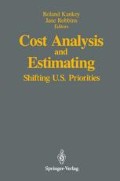Abstract
Learning curve models have gained widespread acceptance as a technique for analyzing and forecasting the cost of items produced from a repetitive process. Considerable research has investigated augmenting the traditional learning curve model with the addition of a production rate variable, creating a rate adjustment model. This study compares the predictive accuracy of the learning curve and rate adjustment models. A simulation methodology is used to vary conditions along seven dimensions. Forecast errors are analyzed and compared under the various simulated conditions, using ANOVA. As in all simulation studies, findings must be interpreted in light of the assumptions underlying the simulation. Overall results indicate that neither model dominates; each is more accurate under some conditions. Conditions under which each model tends to result in lower forecast errors are identified and discussed. This work was sponsored by the Cost Estimating and Analysis Division of the Naval Sea Systems Command and the Naval Postgraduate School.
Access this chapter
Tax calculation will be finalised at checkout
Purchases are for personal use only
Preview
Unable to display preview. Download preview PDF.
References
Alchian, A. (1963), “Reliability of Progress Curves in Airframe Production,” Econometrica, Vol. 31, pp. 679–693.
Asher, H. (1956), Cost-Quantity Relationships in the Airframe Industry, R-291, RAND Corporation, Santa Monica, CA.
Balut, S. (1981), “Redistributing Fixed Overhead Costs,” Concepts, Vol. 4, No. 2, pp. 63–72.
Balut, S., T. Gulledge, Jr., N. Womer (1989), “A Method of Repricing Aircraft Pro-curement,” Operations Research, Vol. 37, pp. 255–265.
Bemis, J. (1981), “A Model for Examining the Cost Implications of Production Rate,” Concepts, Vol. 4, No. 2, pp. 84–94.
Boger, D., S. Liao (1990), “The Effects of Different Production Rate Measures and Cost Structures on Rate Adjustment Models,” in W. Greer, D. Nussbaum, editors, Cost Analysis and Estimating Tools and Techniques, Springer-Verlag, New York, 1990, pp. 82–98.
Cheney, W. (1977), Strategic Implications of the Experience Curve Effect for Avionics Acquisition by the Department of Defense, Ph. D. Dissertation, Purdue University, West Lafayette, IN.
Cochran, E. (1960), “New Concepts of the Learning Curve,” Journal of Industrial Engineering,” Vol. 11, pp. 317–327.
Conway, R., A. Schultz (1959), “The Manufacturing Progress Function,” Journal of Industrial Engineering, 10, pp. 39–53.
Cox, L., J. Gansler (1981), “Evaluating the Impact of Quantity, Rate, and Competition,” Concepts, Vol. 4, No. 4, pp. 29–53.
Dorsett, J. (1990), “The Impacts of Production Rate on Weapon System Cost,” paper presented at the Joint Institute of Cost Analysis/National Estimating Society National Conference, Los Angeles, CA, June 20–22.
Gulledge, T., N. Womer (1986), The Economics of Made-to-Order Production, Springer-Verlag, New York, NY.
Hirsch, W. (1952), “Manufacturing Progress Functions,” The Review of Economics and Statistics, Vol. 34, pp. 143–155.
Large, J., H. Campbell, D. Cates (1976), Parametric Equations for Estimating Aircraft Airframe Costs, R-1693-1- PA&E, RAND Corporation, Santa Monica, CA.
Large, J., K. Hoffmayer, F. Kontrovich (1974), Production Rate and Production Cost, R-1609-PA&E, The RAND Corporaton, Santa Monica, CA.
Levenson, G., et. al. (1971), Cost Estimating Relationships for Aircraft Airframes, R-761-PR, RAND Corporation, Santa Monica, CA.
Liao, S. (1988), “The Learning Curve: Wright’s Model vs. Crawford’s Model,” Issues in Accounting Education, Vol. 3, No. 2, pp. 302–315.
Linder, K., C. Wilbourn (1973), “The Effect of Production Rate on Recurring Missile Costs: A Theoretical Model,” Proceedings, Eighth Annual Department of Defense Cost Research Symposium, Airlie VA, compiled by Office of the Comptroller of the Navy, 276–300.
McCullough, J., S. Balut (1986), Defense Contractor Indirect Costs: Trends, 1973–1982, IDA P-1909, Institute for Defense Analysis, Alexandria, VA
Moses, O. (1990), Extensions to the Learning Curve: An Analysis of Factors Influencing Unit Cost of Weapon Systems, Naval Postgraduate School Technical Report, NPS-54-90-016, Monterey, CA
Pilling, D. (1989), Competition in Defense Procurement, The Brookings Institution, Washington DC, p. 35.
Smith, C. (1980), Production Rate and Weapon System Cost: Research Review, Case Studies, and Planning Model, APR080-05, U. S. Army Logistics Management Center, Fort Lee, VA
Smith, C. (1981), “Effect of Production Rate on Weapon System Cost,” Concepts, Vol. 4, No. 2, pp. 77–83.
Smith, L. (1976), An Investigation of Changes in Direct Labor Requirements Resulting From Changes in Airframe Production Rate, Ph. D. dissertation, University of Oregon, Eugene, OR.
Smunt, T. (1986), “A Comparison of Learning Curve Analysis and Moving Average Ratio Analysis for Detailed Operational Planning,” Decision Sciences, Vol. 17, No. 4, Fall, pp. 475–494.
Washburn, A (1972), “The Effects of Discounting Profits in the Presence of Learning in the Optimization of Production Rates,” AIIE Transactions, 4, pp. 255–313.
Wetherill, G. (1986), Regression Analysis with Applications, Chapman and Hall, New York.
Womer, N. (1979), “Learning Curves, Production Rate and Program Costs,” Management Science, Vol. 25, No. 4, April, pp. 312–319.
Wright, T. (1936), “Factors Affecting the Cost of Airplanes,” Journal of Aeronautical Sciences, Vol. 3, pp. 122–128.
Yelle, L. (1979), “The Learning Curve: Historical Review and Comprehensive Survey,” Decision Sciences, Vol. 10, No. 2, April, pp. 302–328.
Author information
Authors and Affiliations
Editor information
Editors and Affiliations
Rights and permissions
Copyright information
© 1991 Springer-Verlag New York Inc.
About this paper
Cite this paper
Moses, O.D. (1991). Learning Curve and Rate Adjustment Models: Comparative Prediction Accuracy Under Varying Conditions. In: Kankey, R., Robbins, J. (eds) Cost Analysis and Estimating. Springer, New York, NY. https://doi.org/10.1007/978-1-4612-3202-5_4
Download citation
DOI: https://doi.org/10.1007/978-1-4612-3202-5_4
Publisher Name: Springer, New York, NY
Print ISBN: 978-1-4612-7831-3
Online ISBN: 978-1-4612-3202-5
eBook Packages: Springer Book Archive

